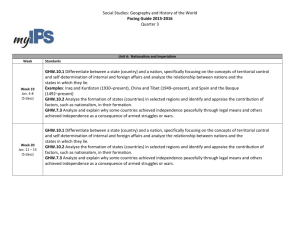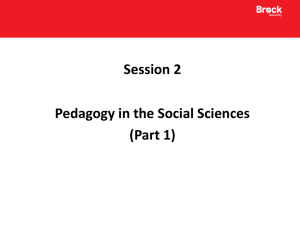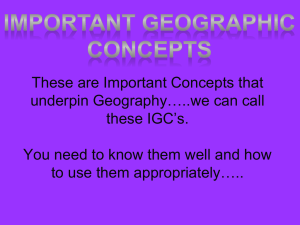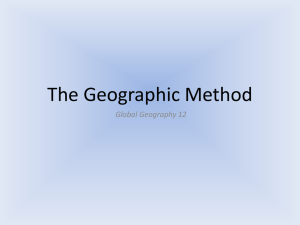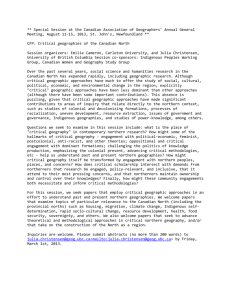KINDERGARTEN - Indiana Council for the Social Studies
advertisement
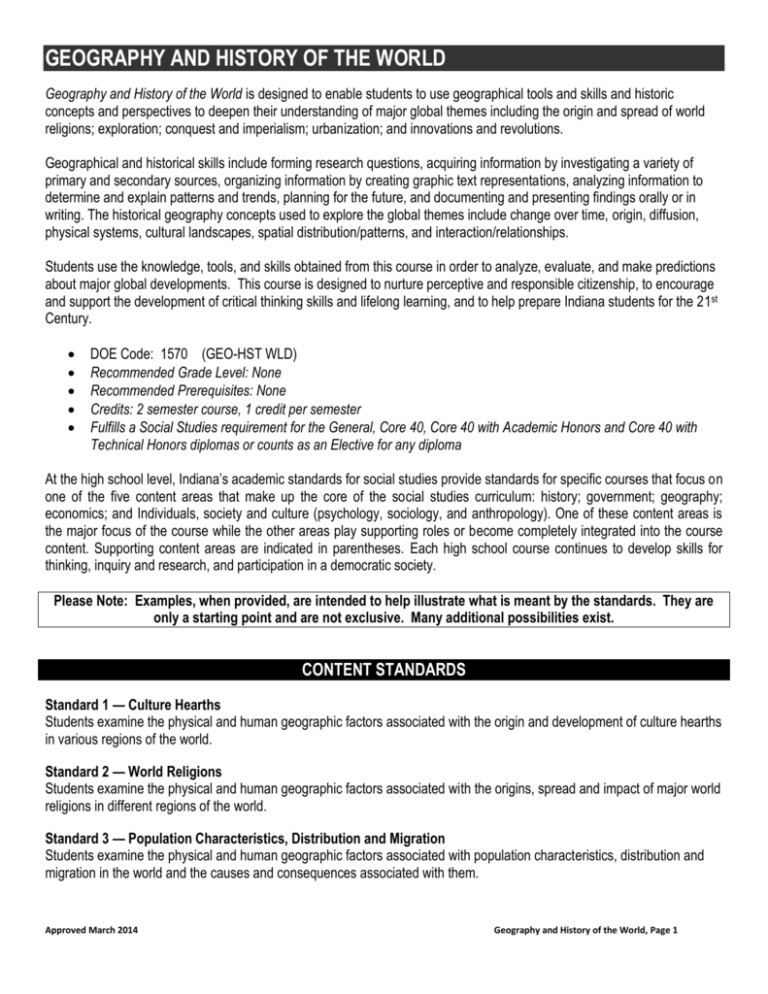
GEOGRAPHY AND HISTORY OF THE WORLD Geography and History of the World is designed to enable students to use geographical tools and skills and historic concepts and perspectives to deepen their understanding of major global themes including the origin and spread of world religions; exploration; conquest and imperialism; urbanization; and innovations and revolutions. Geographical and historical skills include forming research questions, acquiring information by investigating a variety of primary and secondary sources, organizing information by creating graphic text representations, analyzing information to determine and explain patterns and trends, planning for the future, and documenting and presenting findings orally or in writing. The historical geography concepts used to explore the global themes include change over time, origin, diffusion, physical systems, cultural landscapes, spatial distribution/patterns, and interaction/relationships. Students use the knowledge, tools, and skills obtained from this course in order to analyze, evaluate, and make predictions about major global developments. This course is designed to nurture perceptive and responsible citizenship, to encourage and support the development of critical thinking skills and lifelong learning, and to help prepare Indiana students for the 21st Century. DOE Code: 1570 (GEO-HST WLD) Recommended Grade Level: None Recommended Prerequisites: None Credits: 2 semester course, 1 credit per semester Fulfills a Social Studies requirement for the General, Core 40, Core 40 with Academic Honors and Core 40 with Technical Honors diplomas or counts as an Elective for any diploma At the high school level, Indiana’s academic standards for social studies provide standards for specific courses that focus on one of the five content areas that make up the core of the social studies curriculum: history; government; geography; economics; and Individuals, society and culture (psychology, sociology, and anthropology). One of these content areas is the major focus of the course while the other areas play supporting roles or become completely integrated into the course content. Supporting content areas are indicated in parentheses. Each high school course continues to develop skills for thinking, inquiry and research, and participation in a democratic society. Please Note: Examples, when provided, are intended to help illustrate what is meant by the standards. They are only a starting point and are not exclusive. Many additional possibilities exist. CONTENT STANDARDS Standard 1 — Culture Hearths Students examine the physical and human geographic factors associated with the origin and development of culture hearths in various regions of the world. Standard 2 — World Religions Students examine the physical and human geographic factors associated with the origins, spread and impact of major world religions in different regions of the world. Standard 3 — Population Characteristics, Distribution and Migration Students examine the physical and human geographic factors associated with population characteristics, distribution and migration in the world and the causes and consequences associated with them. Approved March 2014 Geography and History of the World, Page 1 Standard 4 — Exploration, Conquest, Imperialism and Post-Colonialism Students examine the physical and human geographic factors associated with the origins, major players and events, and consequences of worldwide exploration, conquest and imperialism. Standard 5 — Urban Growth Students examine the physical and human geographic factors associated with the origin and growth of towns and cities in different regions of the world and with the internal spatial structure of those urban centers. Standard 6 — Innovations and Revolutions Students examine physical and human geographic factors that influenced the origins, major events, diffusion and global consequences of new ideas in agriculture, science, culture, politics, industry and technology. Standard 7 — Conflict and Cooperation Students explore the physical and human geographic factors affecting the origins and the local, regional and supranational consequences of conflict and cooperation between and among groups of people. Standard 8 — Trade and Commerce Students examine the physical and human geographic factors that encourage or impede economic interdependence between and/or among countries and the local, regional and global consequences of those exchanges. Standard 9 — Human and Environmental Interactions: Resources, Hazards and Health Students examine the physical and human geographic factors associated with examples of how humans interact with the environment, such as deforestation, natural hazards and the spread of diseases, and the regional and global consequences of these interactions. Standard 10 — States, Nations and Nation-States Students analyze and evaluate the physical and human geographic factors that contribute to the formation of states (countries) and the forces that function to either unite and bind a country together or to divide a country. Standard 11 — Sports, Recreation and Tourism Students examine the physical and human geographic factors associated with sports, recreation and tourism along with the local and global consequences of these activities. Standard 12 — Global Change Students examine the human causes of change to the environment on a global scale along with the impact of these changes on the lives of humans. Approved March 2014 Geography and History of the World, Page 2 Standard 1: Culture Hearths Students examine the physical and human geographic factors associated with the origin and development of culture hearths in various regions of the world. GHW.1.1 Use maps, timelines and/or other graphic representations to identify and describe the location, distribution and main events in the development of culture hearths in Asia, Mesoamerica and North Africa. Examples: Irrigation-based civilizations; Rainforest; Land-based civilization GHW.1.2 Ask and answer geographic and historical questions about the locations and growth of culture hearths. Assess why some of these culture hearths have endured to this day, while others have declined or disappeared GHW.1.3 Analyze agricultural hearths and exchanges of crops among regions. Evaluate the impact of agriculture on the subsequent development of culture hearths in various regions of the world. GHW.1.4 Identify and describe the factors that explain how the local and regional human and physical environments of selected culture hearths were modified over time in terms of such features as urban development and agricultural activities. Standard 2: World Religions Students examine the physical and human geographic factors associated with the origins, spread and impact of major world religions in different regions of the world. GHW.2.1 Map the development over time of world religions from their points of origin and identify those that exhibit a high degree of local and/or international concentration. Examples: Universal religions/beliefs: Judaism (Jerusalem), Christianity (Jerusalem), Islam (Mecca, Medina) and Buddhism (Varanasi); Ethnic religions: Hinduism (Indus River), Confucianism and Taoism (Yellow River), Shintoism (Japan) GHW.2.2 Differentiate among selected countries in terms of how their identities, cultural and physical environments, and functions and forms of government are affected by world religions. Examples: Spain: Muslim, Jewish and Christian influences on government, considering their similarities and differences (100–1500); Russia: influences of the Eastern Orthodox Church (1400–1917); Iran and Iraq: how religion (Shia Islam and Sunni Islam) affects culture and government (1917–present); Israel: the Jewish state and a possible future Palestinian State (1948–present) GHW.2.3 Compare and contrast different religions in terms of perspectives on the environment and attitudes toward resource use, both today and in the past. Examples: Japan (Shintoism and Buddhism): natural beauty; India (Hinduism and Jainism): reverence for living things, especially for selected animal species; Sub-Saharan Africa (rise of animism): animistic perception of land, resources and natural events; Western World (Christianity): environment and attitudes toward resource use Approved March 2014 Geography and History of the World, Page 3 GHW.2.4 Analyze and assess the rise of fundamentalist movements in the world’s major religions during contemporary times (1980–present) and describe the relationships between religious fundamentalism and the secularism and modernism associated with the Western tradition. Examples: Shiite Islamic fundamentalism in Iran and its view of the West in general and the United States in particular as “The Great Satan” (1970–present); fundamentalism in India and its relationship to the government of India (1980–present) Standard 3: Population Characteristics, Distribution and Migration Students examine the physical and human geographic factors associated with population characteristics, distribution and migration in the world and the causes and consequences associated with them. GHW.3.1 Map and analyze the distribution of the world’s human population for different time periods noting the population characteristics and population density for specific regions. GHW.3.2 Identify and describe the push-pull factors that resulted in the migration of human population over time and detect changes in these factors. GHW.3.3 Analyze the changes in population characteristics and physical and human environments that resulted from the migration of peoples within, between, and among world regions. GHW.3.4 Give examples of and evaluate how the physical and human environments in different regions have changed over time due to significant population growth or decline. GHW.3.5 Analyze population trends in the local community and suggest the impact of these trends on the future of the community in relation to issues such as development, employment, health, cultural diversity, schools, political representation and sanitation. Standard 4: Exploration, Conquest, Imperialism and Post-Colonialism Students examine the physical and human geographic factors associated with the origins, major players and events, and consequences of worldwide exploration, conquest and imperialism. GHW.4.1 Explain the causes and conditions of worldwide voyages of exploration, discovery and conquest. Identify the countries involved. Provide examples of how people modified their view of world regions as a consequence of these voyages. GHW.4.2 Use a variety of text (writing, maps, timelines and/or other graphic representations) to show the movement, spread and changes in the worldwide exchange of flora, fauna and pathogens that resulted from transoceanic voyages of exploration and exchanges between peoples in different regions. Assess the consequences of these encounters for the people and environments involved. GHW.4.3 Identify and compare the main causes, players, and events of imperialism during different time periods. Examine the global extent of imperialism using a series of political maps. Approved March 2014 Geography and History of the World, Page 4 GHW.4.4 Analyze and assess how the physical and human environments (including languages used) of places and regions changed as the result of differing imperialist and colonial policies. Examples: Native Americans in Mesoamerica in relationship to Spanish conquistadors, missionaries and traders; Africa and the Atlantic slave trade involving Europeans and Africans; the Arabic-Islamic slave trade involving indigenous African peoples and directed northward and eastward within the continent of Africa and into the Middle East; and the slave trade involving only indigenous black Africans in the interior of the continent; economic dislocations in India (1500–1947) GHW.4.5 Analyze and assess ways that colonialism and imperialism have persisted and continue to evolve in the contemporary world. Standard 5: Urban Growth Students examine the physical and human geographic factors associated with the origin and growth of towns and cities in different regions of the world and with the internal spatial structure of those urban centers. GHW.5.1 Ask and answer geographic and historic questions about the origin and growth of towns and cities in different regions of the world and in different time periods. Compare and contrast the factors involved in the location and growth of towns and cities for different time periods. GHW.5.2 Describe, using a variety of text (writing, maps, timelines and/or other graphic presentations), the worldwide trend toward urbanization and the changing function of cities. Assess the impact of factors such as locational advantages and disadvantages, changing transportation technologies, population growth, changing agricultural production, and the demands of industry on this trend. Examples: Latin America: compare and contrast the urban centers of Mexico, Brazil and Peru (1800– present); New Orleans: growth as gateway to the heartland of the United States (1803–present); Tokyo: from semi-isolation to widespread international interaction (1853–present) Describe how the internal structure of cities is similar and different in various regions of the world. Analyze and explain why these similarities and differences in structure exist. Examples: Examine similarities and differences among the urban development of Salt Lake City (central temple focus), Paris (circular with spokes), Rio de Janeiro (physical geographic constraints of sea and mountains), and Mumbai (peninsular location) GHW.5.3 GHW.5.4 Analyze and assess the impact of urbanization on the physical and human environments in various parts of the world. Approved March 2014 Geography and History of the World, Page 5 Standard 6: Innovations and Revolutions Students examine physical and human geographic factors that influenced the origins, major events, diffusion and global consequences of new ideas in agriculture, science, culture, politics, industry and technology. GHW.6.1 Distinguish between violent and non-violent revolution. Describe the causes and events of political revolutions in two distinct regions of the world and use maps, timelines and/or other graphic representations to document the spread of political ideas that resulted from those events to other regions of the world. GHW.6.2 Prepare maps, timelines and/or other graphic representations showing the origin and spread of specific innovations (e.g. Explosives; paper; printing press; steam engine; pasteurization; electricity; immunization; atomic energy; and computer and digital technology) . Assess the impact of these innovations on the human and physical environments of the regions to which they spread. GHW.6.3 Map the spread of innovative art forms and scientific thought from their origins to other world regions. Analyze how the spread of these ideas influenced developments in art and science for different places and regions of the world. Examples: Italian Renaissance and the growth of egg tempera paintings and frescoes, chemistry of oil paints (1500s); European Renaissance and the development of scientific ideas (1600–1800); England and the Industrial Revolution and its diffusion (1700–present); compare and contrast the spread of Asian, African and Latin American art forms (1900s–present); development of twentieth century music (jazz, etc.) in North America (1900s–present) GHW.6.4 Analyze how transportation and communication changes (e.g. Railroads; Automobiles and Airplanes; Computer Technology; Television; Cell Phones; Satellite Communications) have led to both cultural convergence and divergence in the world. GHW.6.5 Analyze and assess the impact of the four major agricultural revolutions* on the world’s human and physical environments. * agricultural revolutions, in historical order: (1) fire used to alter natural vegetation; (2) domestication of plants; (3) industrialization and mechanization of agriculture with use of fertilizers, pesticides and herbicides; (4) applied microscopia for selective genetic manipulation GHW.6.6 Compare and contrast the impact of the Industrial Revolution on developed countries with the economic processes acting upon less developed, and developing, countries in the contemporary world. Standard 7: Conflict and Cooperation Students explore the physical and human geographic factors affecting the origins and the local, regional and supranational* consequences of conflict and cooperation between and among groups of people. GHW.7.1 Recognize that conflict and cooperation among groups of people occur for a variety of reasons including nationalist, racial, ethnic, religious, political, economic and resource concerns that generally involve agreements and disagreements related to territory on Earth’s surface. Examples: Turkey and Iraq conflict and cooperation related to the headwaters of the Tigris and Euphrates Rivers (1900–present), U.S. and Canada conflict and cooperation related to salmon in the Straits of Georgia and Juan de Fuca (1950–present), and conflict within the country of Sudan between Arabic peoples in the north and black Africans in the south (1950–present) Approved March 2014 Geography and History of the World, Page 6 GHW.7.2 Analyze the physical and human factors involved in conflicts and violence related to nationalist, racial, ethnic, religious, economic, political, and/or resource issues in various parts of the world, over time. Assess the human and physical environmental consequences of the conflicts identified for study. Examples: Indian Sub-continent: British vs. Muslims vs. Hindus (1800-present); Northern Ireland: Protestants vs. Catholics (1900s); Southwest Asia: Iranians vs. Iraqi Shiites vs. Sunnis; Israelis vs. Palestinians vs. Arabs (1900s-present); Africa: tribal conflicts in Rwanda, Nigeria and Sudan (1900s-present); Europe: the creation of new nations from the former Austro-Hungarian and Russian Empires (1914-present); World War II and the Holocaust (1933-1945) GHW.7.3 Analyze and explain why some countries achieved independence peacefully through legal means and others achieved independence as a consequence of armed struggles or wars. Examples: Compare and contrast Czech Republic and Slovakia to former Yugoslavia (1900s), compare and contrast Ghana under Nkrumah and Kenya under Kenyatta (1950–70s), compare and contrast Gandhi’s (India) non-violent approach to independence compared to Algerian violent movement for independence from France (1950s) or to the Bolshevik’s (Russia) approach to independence from absolutism (1900s), and compare and contrast the independence movements by colonial Australia and South Africa (1900s) GHW.7.4 Prepare a variety of text (writing, maps, timelines and/or other graphic representations) to trace the development and geographic extent of a variety of regional and global cooperative organizations for different time periods. Describe their establishment and assess their success or lack of success, consequences for citizens, and the role of particular countries in achieving the goals the organizations were established to accomplish. Examples: League of Nations, North Atlantic Treaty organization (NATO), United Nations (UN), North American Free Trade Association (NAFTA), Free Trade Association (FTA), World Trade Organization (WTO), World Health Organization (WHO), European Union (EU), Triple Entente, Quintuple Alliance and Free Trade Area of the Americas (FTAA) Standard 8: Trade and Commerce Students examine the physical and human geographic factors that encourage or impede economic interdependence between and/or among countries and the local, regional and global consequences of those exchanges. GHW.8.1 Use maps to show the location and distribution of Earth’s resources and analyze how this distribution affects trade between and among countries and regions. GHW.8.2 Prepare graphic representations, such as maps, tables and timelines, to describe the global movement of goods and services between and among countries and world regions over time. Analyze and assess the patterns and networks of economic interdependence or lack of interdependence that result Examples: Latin American and Africa: describe near-subsistence agriculture (1800–present), United States: relate resources to the interstate highway system (present), Russia: discuss the importance of the BAM (Baikal-Amur Mainline Railway) project and the Trans-Siberian railroad system in making more resources accessible to world trade (present), Europe and China: compare and contrast the movement of goods and services (present) Approved March 2014 Geography and History of the World, Page 7 GHW.8.3 Analyze the impact of changing global patterns of trade and commerce on the state and local community and predict the impact of these patterns in the future. Standard 9: Human and Environmental Interactions: Resources, Hazards and Health Students examine the physical and human geographic factors associated with examples of how humans interact with the environment, such as deforestation, natural hazards and the spread of diseases, and the regional and global consequences of these interactions. GHW.9.1 Use maps to identify regions in the world where particular natural disasters occur frequently and analyze how the physical and human environments have been modified over time in response to environmental threats. Assess the success of international aid to these disasters. GHW.9.2 Identify regional resource issues that may impede sustainability, economic expansion and/or diversification and assess the impact of these issues on the physical and human environments of specific regions Examples: United States: distribution of fresh water in western states; African Sahel: overgrazing vegetation, compounding effects of drought and consequent desertification; Europe: dependence on the Persian Gulf for fossil energy. GHW.9.3 Identify and describe ways in which humans have used technology to modify the physical environment in order to settle areas in different world regions and evaluate the impact of these technologies on the physical and human environments affected. Examples: Netherlands: use of dams and dikes; United States (New Orleans): levees and dams; China: Three Gorges Dam on Yangtze River (Chang Jiang); Southwest Asia (Qatar and United Arab Emirates): changing the desert into areas of agriculture productivity and developing urban centers GHW.9.4 Distinguish and assess the human and physical factors associated with the spread of selected epidemics and/or pandemics over time Examples: Bubonic Plague, smallpox, cholera pandemic, Influenza pandemic, and describe the impact of this diffusion on countries and regions. Propose strategies for limiting the spread of diseases. Approved March 2014 Geography and History of the World, Page 8 Standard 10: States, Nations and Nation-States Students analyze and evaluate the physical and human geographic factors that contribute to the formation of states (countries) and the forces that function to either unite and bind a country together or to divide a country. GHW.10.1 Differentiate between a state (country) and a nation, specifically focusing on the concepts of territorial control and self-determination of internal and foreign affairs and analyze the relationship between nations and the states in which they lie. Examples: Iraq and Kurdistan (1930–present), China and Tibet (1949–present), and Spain and the Basque (1492–present) GHW.10.2 Analyze the formation of states (countries) in selected regions and identify and appraise the contribution of factors, such as nationalism, in their formation. Examples: The development of the United States from the 13 colonies (1763–1825), the development of the countries of Columbia and Venezuela from the Viceroyalty of New Granada (1775–1825), the formation of Germany (1848–1989), the formation of the Republic of China on Taiwan (1945–present), potential nationalistic movements with the Palestinians and Kurds (present) GHW.10.3 Evaluate and predict the successes and failures of democratic reform movements in challenging authoritarian or despotic regimes in different countries. Examples: Brazil: formation (1820–1875), Russia: from Czar to federalism (1905–1995), the future of Iraq (1945–present), Korea (1945–present), South Africa: from white supremacy to black majority rule with protection of the rights of minorities (1900s), Nigeria: from dictatorship to democracy (1960–present) GHW.10.4 Investigate and assess the impact of imperialistic policies on the formation of new countries in various regions of the world. Examples: The Netherlands and Indonesia (1750–1945), Great Britain and Kenya (1870–1970), Belgium and the Congo (1870–1970), France and Indo-China (1890–1954), United States and the Philippines (1898–1947), Portugal and Angola (1925–1975), and Japan and Korea (1910–1945) GHW.10.5 Use a variety of sources, such as atlases, written materials and statistical source materials, to identify countries of the world that are true nation-states and draw conclusions about why certain regions of the world contain more nation-states than others. Examples: The development of France (500–1850), compare Europe with Africa (1700–1990), the emergence of the federal state of Australia (1775–1925) and the increase of homogeneity in Japan (1945–present) GHW.10.6 Analyze the human and physical geographic forces that either bind and unite (centripetal forces) or divide (centrifugal forces) a country or countries. Predict the impact of these forces on the future of these countries and analyze possible strategies that could be implemented to overcome the impact of centrifugal forces. Examples: Switzerland and Yugoslavia (1200–present); the emergence of countries in the Indian sub-continent (1775–1985); the road to federalism in Nigeria (1925–present); and the evolution of countries of contemporary Europe, such as Great Britain, France, Spain and Italy Approved March 2014 Geography and History of the World, Page 9 Standard 11: Sports, Recreation and Tourism Students examine the physical and human geographic factors associated with sports, recreation and tourism along with the local and global consequences of these activities. GHW.11.1 GHW.11.2 Use graphic representations, such as maps and timelines, to describe the spread of specific sports and/or sporting events from their geographic origins and analyze the spatial patterns that emerge. Analyze the ways in which people’s changing views of particular places and regions as recreation and/or tourist destinations reflect cultural changes. Examples: Italy (Florence, Venice and Rome): formerly political, religious and commercial centers, becoming tourist centers; China: potential for significant political and cultural change due to the Olympic movement; and United States: development of parks in response to increased urbanization GHW.11.3 Identify and assess the impact of sports and recreation on the human and physical environments in selected countries. GHW.11.4 Analyze and predict the changing patterns of space devoted to sports and recreation in the local community and region. Examples: Indianapolis: downtown renewal, West Lafayette: university expansion of sporting facilities, South Bend: national reputation related to sports, and Paoli: basketball stadium holds more than the town’s population GHW.11.5 Analyze the impact of tourism on the physical and human environments of selected world regions. Predict the environmental impact of a continued growth in tourism in these regions. GHW.11.6 Use geographical and historical knowledge and skills to analyze problems related to tourism and to propose solutions related to these problems. Standard 12: Global Change Students examine the human causes of change to the environment on a global scale along with the impact of these changes on the lives of humans. GHW.12.1 Analyze global climate change (sometimes called “global warming”) and assess the validity of this idea, the variable climate changes it forecasts for different parts of Earth, and the implications of these changes for humans. GHW.12.2 Explain the concepts of linear and exponential growth, and apply these concepts to geographical themes while analyzing the consequences of various human responses. Examples: The “doubling time” for global population and the implications of this doubling in various world regions (1750–present), economic growth curves for various countries and the implications for resource use and environmental pollution (present) Approved March 2014 Geography and History of the World, Page 10

